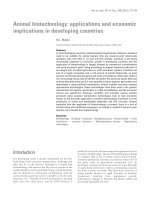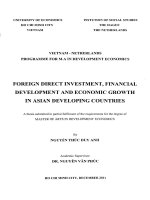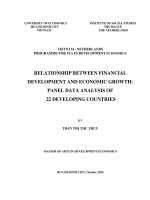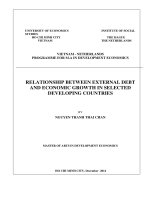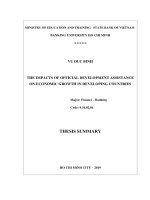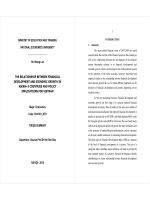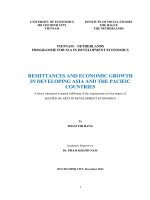Tourism development and economic growth in developing countries
Bạn đang xem bản rút gọn của tài liệu. Xem và tải ngay bản đầy đủ của tài liệu tại đây (709 KB, 13 trang )
The International Journal of Business and Finance Research ♦ Volume 6 ♦ Number 1 ♦ 2012
TOURISM DEVELOPMENT AND ECONOMIC
GROWTH IN DEVELOPING COUNTRIES
E. M. Ekanayake, Bethune-Cookman University
Aubrey E. Long, Bethune-Cookman University
ABSTRACT
The objective of this study is to investigate the relationships between tourism development and economic
growth in developing countries using the newly developed heterogeneous panel cointegration technique.
This study examines the causal relationship between tourism development and economic growth using
Granger causality tests in a multivariate model and using the annual data for the 1995–2009 period. The
study finds no evidence to support the tourism-led growth hypothesis. The results of the FMOLS show that,
though the elasticity of tourism revenue with respect to real GDP is not statistically significant for all
regions, its positive sign indicates that tourism revenue makes a positive contribution to economic growth
in developing countries. The results of the study suggest that governments of developing countries should
focus on economic policies to promote tourism as a potential source of economic growth.
JEL: F43, L83, O40
KEYWORDS: Tourism, economic growth, panel cointegration, causality
INTRODUCTION
T
ourism industry has emerged as one of the leading service industries in the global economy in
recent decades. Economic flows generated by international tourism have become vital factors in
economic growth and international economic relations in many developing countries. For example,
according to the World Tourism Organization (2010), as a result of an ever increasing number of
destinations opening up and investing in tourism development, modern tourism has become a key driver
for socio-economic progress through the creation of jobs and enterprises, infrastructure development, and
the export revenues earned. In addition, the contribution of tourism to worldwide economic activity is
estimated at some 5% while its contribution to employment is estimated in the order of 6-7% of the
overall number of direct and indirect jobs worldwide. According to the World Tourism Organization,
between 1970 and 2009, there was a 48-fold increase in international tourism receipts rising from
US$17.9 billion in 1970 to US$852 billion in 2009.
The importance of the tourism sector can further be understood based on recent statistics available from
the World Travel & Tourism Council. According to the World Travel & Tourism Council's latest
economic impact report (The World Travel & Tourism Council, 2011), the industry’s direct
contribution to global GDP increased by 3.3% in 2010 to US$1,770 billion and is expected to rise further
by 4.5% to US$1,850 billion in 2011, creating an additional 3 million direct industry jobs. In addition,
taking into account its wider economic impacts, travel and tourism’s total economic contribution in 2011
is expected to account for US$5,987 billion or 9.1% of global GDP, and for 258 million jobs. The report
also predicts that the direct contribution of travel and tourism to GDP is expected rise by 4.2% annually to
US$2,860.5 billion (in constant 2011 prices) in 2021. In addition, the total contribution of travel and
tourism to employment, including jobs indirectly supported by the industry, is forecast to be 258.6 million
jobs (8.8% of total employment), visitor exports are expected to generate US$1,162.7 billion (5.8% of
total exports), and total industry investment is estimated at US$652.4 billion or 4.5% of total investment
in 2011.
51
Electronic copy available at: />
E. M. Ekanayake & A. E. Long IJBFR ♦ Vol. 6 ♦ No. 1 ♦ 2012
Thus the tourism sector has become increasingly important industry to many developing countries as a
source of revenue as well as a source of employment. Tourism generates a vital amount of foreign
exchange earnings that contributes to the sustainable economic growth and development of developing
countries. Given its increasing importance in the global economy, tourism sector has gained much
attention in recent academic literature. According to Balaguer and Cantavella-Jorda (2002), international
tourism would contribute to an income increase at least in two different ways as the export-led growth
hypothesis postulates. First, enhancing efficiency through competition between local firms and the ones
corresponding to other international tourist destinations, and second, facilitating the exploitation of
economies of scale in local firms. The objective of this study is to investigate the relationships between
tourism development and economic growth in developing countries. This study examines the causal
relationship between tourism development and economic growth in developing countries in a multivariate
model using the annual data for the 1995–2009 period.
The remainder of the paper is organized as follows: Section 2 provides a brief literature review. In Section
3, the empirical framework of the current study is set out by specifying model as well as the econometric
methodology. Section 4 discusses the variable definitions and outlines the data sources. Empirical results
of panel unit root tests, panel cointegration tests, and error-correction model estimates are presented in
Section 5. The last section, Section 6 presents a summary and a brief conclusion as to the results obtained
in this study.
REVIEW OF LITERATURE
There are a large number of studies done on tourism and economic growth. These studies can be grouped
into two broad categories, namely, single-country studies and country-group studies. Due to the limitation
of resources, this review is limited to some of the most recent studies. The empirical results from previous
studies on the causal relationship between tourism expansion and economic growth are mostly mixed. For
example, Kreishan (2010), Lee and Chang (2008), Kim, et al. (2006), Dritsakis (2004), Durbarry (2004),
and Balaguer and Cantavella-Jorda (2002) find evidence supporting the tourism-led economic growth
hypothesis. The economic-driven tourism growth hypothesis is supported in studies by Katircioglu (2009),
Oh (2005), Narayan (2004), and Lanza et al. (2003). Although relatively few, the reciprocal hypothesis is
still supported by, for example, Arslanturk, et al. (2011), Kim, et al. (2006) and Shan and Wilson (2001).
The Granger causality test has been widely used in the literature in analyzing the relationship between
tourism and economic growth. For a comprehensive survey of current literature on tourism demand and is
impact on the economy, please see Song and Li (2008) and Li, Song, and Witt (2005).
A recent study by Schubert, Brida, and Risso (2011) examines the impacts on economic growth of a small
tourism-driven economy caused by an increase in the growth rate of international tourism demand. The
study uses annual data of Antigua and Barbuda from 1970 to 2008. The model shows that an increase in
the growth of tourism demand leads to transitional dynamics with gradually increasing economic growth
and increasing terms of trade. The authors perform a cointegration analysis to look for the existence of a
long-run relationship among variables of economic growth, international tourism earnings and the real
exchange rate. The exercise confirms the theoretical findings.
Arslanturk, Balcilar, and Ozdemir (2011) investigates the causal link between tourism receipts and GDP
in Turkey for the period 1963-2006. The study uses the rolling window and time-varying coefficients
estimation methods to analyze the Granger causality based on Vector Error Correction Model (VECM).
The findings of the paper indicate that there is no Granger causality between the series, while the findings
from the time-varying coefficients model based on the state-space model and rolling window technique
show that GDP has no predictive power for tourism receipts. However, tourism receipts have a positive–
predictive content for GDP following early 1980s.
52
Electronic copy available at: />
The International Journal of Business and Finance Research ♦ Volume 6 ♦ Number 1 ♦ 2012
A study by Kreishan (2010) examines the causality relations between tourism earnings and economic
growth for Jordan, using annual data covering the period 1970-2009. The findings of the study showed
that there is a positive relationship between tourism development and economic development in the longrun. Moreover, the Granger causality test results revealed the presence of unidirectional causality from
tourism earnings to economic growth. In a similar study, Zortuk (2009) focuses on investigating the
contribution of tourism sector to economic growth in Turkey. The data pertaining to 1990Q1 and 2008Q3
periods were used in the study and the relationship between the expansion in tourism and economic
growth was investigated using granger causality test based on vector error-correction model and finds
evidence for unidirectional causality from tourism development to economic development exists between
the two variables.
Katircioglu (2009) employs the bounds test for cointegration and Granger causality tests to investigate a
long-run equilibrium relationship between tourism, trade and real income growth, and the direction of
causality among themselves for Cyprus. Data used in the study are annual figures covering the period
1960–2005. The results of the study reveal that tourism, trade and real income growth are cointegrated;
thus, a long-run equilibrium relationship can be inferred between these three variables. In addition,
Granger causality test results suggest that real income growth stimulates growth in international trade
(both exports and imports) and international tourist arrivals to the island.
A study by Lee and Chang (2008) applies the new heterogeneous panel cointegration technique to reinvestigate the long-run comovements and causal relationships between tourism development and
economic growth for OECD and non-OECD countries (including those in Asia, Latin America and SubSahara Africa) for the 1990–2002 period. The study finds that tourism development has a greater impact
on GDP in non-OECD countries than in OECD countries, and when the variable is tourism receipts, the
greatest impact is in Sub-Sahara African countries. Additionally, in the long run, the panel causality test
shows unidirectional causality relationships from tourism development to economic growth in OECD
countries, bidirectional relationships in non-OECD countries, but only weak relationships in Asia.
Sequeira and Nunes (2008) use panel data methods to study the relationship between tourism and
economic growth. The study uses annual data for a group of countries covering the period 1980-2002 and
shows that tourism is a positive determinant of economic growth both in a broad sample of countries and
in a sample of poor countries. However, contrary to previous contributions, tourism is not more relevant
in small countries than in a general sample.
Employing the Engle and Granger two-stage approach and a bivariate VAR model of real aggregate
tourism receipts and real GDP, Oh (2005) investigates the causal relations between tourism growth and
economic expansion for the Korean economy. Using quarterly data from 1975Q1 to 2001Q1, the results
of cointegration test indicate that there is no long-run equilibrium relationship between these two series.
In addition, the results of Granger causality test imply the existence of a one-way causal relationship in
terms of economic-driven tourism growth. The hypothesis of tourism-led economic growth, therefore, is
not held in the Korean economy.
Balaguer and Cantavella-Jorda (2002) use a trivariate model of real GDP, real international tourism
earnings, and the real effective exchange rate to examine the role of tourism in the Spanish long-run
economic development and confirms the tourism-led growth hypothesis through cointegration and
causality testing. The study uses quarterly data for the period 1975Q1-1997Q4 and finds that economic
growth in Spain has been sensible to persistent expansion of international tourism. Their results for the
Granger causality test indicate that tourism affects Spain’s economic growth unidirectionally and thus
supports the tourism-led growth hypothesis.
53
E. M. Ekanayake & A. E. Long IJBFR ♦ Vol. 6 ♦ No. 1 ♦ 2012
As pointed out by Po and Huang (2008), since the relationship between tourism and economic growth is
inherently a long-term one, a biased estimate may be the result of an insufficiently large sample size in
the time series, the existence of structural changes, or short-term economic fluctuations. To tackle the
insufficient sample size problem, researchers have started to use panel data. In this article we employ
recently developed panel data techniques and closely follow empirical growth literature to test the
influence of tourism development on economic growth in a broad panel data. Our panel data set includes
140 developing countries and 15 years covering the period from 1995 to 2009.
METHODOLOGY
Model Specification
This section discusses the model specifications to examine the relationship between tourism development
and economic growth. The model is derived, in conventional manner, from a production function in
which tourism receipts is introduced as an input in addition to labor and domestic capital.
In the usual notation the production function can be written as follows:
Y = f ( L, K , TR )
(1)
where Y is the real gross domestic product (GDP) in constant 2000 dollars, L is the labor force in
millions, K is the real gross fixed capital formation (K) in constant 2000 U.S. dollars, and TR is the real
tourism receipts in constant 2000 dollars.
The data is compiled within a panel data framework in light of the relatively short time span of the data.
Assuming (1) to be linear in logs, the estimated model can be written as:
ln Yit = α i + δ i t + β1i ln Lit + β 2i ln K it + β 3i ln TRit + ε it
(2)
where i = 1, 2, 3, ...., N for each country in the panel and t = 1, 2, 3, ...., T refers to the time period. Our
panel data set includes 140 countries and covers 15 years from 1995 to 2009. According to economic
theory, the expected signs of the coefficients β1 and β 2 are positive. If tourism is expected to contribute
to economic growth, the expected sign of β 3 is positive. The parameters α i and δ i allow for countryspecific fixed effects and deterministic trends, respectively while ε it denote the estimated residuals which
represent deviations from the long-run relationship.
Panel Unit Root Tests
Before proceeding to cointegration techniques, we need to verify that all of the variables are integrated to
the same order. In doing so, we have used panel unit roots tests due to Im, Pesaran, and Shin (2003)
(hereafter, IPS). These tests are less restrictive and more powerful than the tests developed by Levin and
Lin (1993) and Levin, Lin, and Chu (2002), which do not allow for heterogeneity in the autoregressive
coefficient. The tests proposed by IPS permit to solve Levin and Lin's serial correlation problem by
assuming heterogeneity between units in a dynamic panel framework. The IPS test will be considered
more important because it is appropriate for a heterogeneous regressive root under an alternative
hypothesis. The basic equation for the panel unit root tests for IPS is as follows:
54
The International Journal of Business and Finance Research ♦ Volume 6 ♦ Number 1 ♦ 2012
p
∆yi ,t = α i + β i yi ,t −1 + ∑ ρij ∆yi ,t − j + ε i ,t
i = 1,2,3,...., N
t = 1,2,3,...., T
(3)
j =1
where yi ,t stands for each variable under consideration in our model, α i is the individual fixed effect,
and p is selected to make the residuals uncorrelated over time. The null hypothesis is that β i = 0 for all i
versus the alternative hypothesis that β i < 0 for some i. The IPS statistic is based on averaging individual
Augmented Dickey-Fuller (ADF) statistics and can be written as follows:
t=
1 N
∑ t iT
N i =1
(4)
where t iT is the ADF t-statistic for country i based on the country specific ADF regression, as in Eq. (3).
IPS show that under the null hypothesis of non-stationary in panel data framework, the t statistic follows
the standard normal distribution asymptotically. The standardized statistic t IPS is expressed as:
t IPS =
1 N
n t − ∑ E[ t iT ρi = 0]
N i =1
N
1
∑ Var[t iT ρi = 0]
N i =1
(5)
Panel Cointegration Tests
We investigate the existence of cointegrating relationship using the standard panel tests for no
cointegration proposed by Pedroni (1999, 2004). These tests allow for heterogeneity in the intercepts and
slopes of the cointegrating equation. Pedroni’s tests provide seven test statistics: Within dimension (panel
tests): (1) Panel ν -statistic; (2) Panel Phillips–Perron type ρ-statistics; (3) Panel Phillips–Perron type tstatistic; and (4) Panel augmented Dickey–Fuller (ADF) type t-statistic. Between dimension (group tests):
(5) Group Phillips–Perron type ρ-statistics; (6) Group Phillips–Perron type t-statistic; and (7) Group ADF
type t-statistic. These statistics are based on averages of the individual autoregressive coefficients
associated with the unit root tests of the residuals for each country in the panel. All seven tests are
distributed asymptotically as standard normal. Following Pedroni (1999, 2004), the heterogeneous panel
and heterogeneous group mean panel of rho (ρ), parametric (ADF), and nonparametric (PP) statistics are
calculated as follows:
Panel ν - statistic:
N T
Zν = ∑∑ Lˆ−112i eˆit2 −1
i =1 t =1
−1
(6a)
Panel ρ - statistic:
N T
Z ρ = ∑∑ Lˆ−112i eˆit2 −1
i =1 t =1
−1 N
T
∑∑ Lˆ
i =1 t =1
−2
11i
(eˆit −1 ∆eˆit − λˆ i )
(6b)
55
E. M. Ekanayake & A. E. Long IJBFR ♦ Vol. 6 ♦ No. 1 ♦ 2012
Panel ADF - statistic:
*2 N T ˆ −2
Zt = ~sNT
L11i eˆ *it2 −1
∑∑
i =1 t =1
−
1
2 N
T
∑∑ Lˆ
i =1 t =1
−2
11i
eˆ*it −1 ∆eˆ*it
(6c)
(eˆit −1 ∆eˆit − λˆ i )
(6d)
Panel PP - statistic:
Z pp
2 N T ˆ−2 2
= ~
σ NT ∑∑ L11i eˆit −1
i =1 t =1
−
1
2 N
T
∑∑ Lˆ
i =1 t =1
−2
11i
Group ρ - statistic:
N
T
~
Z ρ = ∑ ∑ eˆit2 −1
i =1 i =1
−1 T
∑ (eˆ
i =1
it −1
∆eˆit − λˆ i )
(6e)
∆eˆ*it
(6f)
Group ADF - statistic:
N
T
~
Zt = ∑ ∑ si*2 eˆ*it2−1
i =1 i =1
−
1
2 T
∑ eˆ
i =1
*
it −1
Panel PP - statistic:
N
T
~
Z pp = ∑ ∑ σˆ i2 eˆit2 −1
i =1 i =1
−
1
2 T
∑ (eˆ
i =1
it −1
∆eˆit −1 − λˆ i )
(6g)
where
1 ki
j T
1 N
1 T
1 T
2
∑ μˆ it μˆ i ,t − j ; sˆi2 = ∑ μ it2 ; σˆ i2 = sˆi2 + 2λˆ i ; ~
λˆ i = ∑ 1 −
σ NT
= ∑ Lˆ−112i σˆ i2 ; sˆ*i 2 = ∑ μˆ *it2 ;
T j =1 k i + 1 t = j +1
N i =1
T t =1
T t =1
ki
T
T
N
~s *2 = 1 sˆ*2 ; and Lˆ2 = 1 ηˆ 2 + 2 1 − j ηˆ ηˆ
∑ it T ∑
∑i
11i
NT
k + 1 ∑ it i ,t − j .
T t =1
T i =1
j =1
i
t = j +1
The error terms μˆ i, t , μˆ *i , t , and ηˆ i, t are respectively derived from the following auxiliary regressions:
ki
M
j =1
m =1
εˆ it = ρˆ i εˆ i ,t −1 + μˆ it ; εˆ it = ρˆ i εˆ i ,t −1 + ∑ ρˆ ik ∆εˆ i ,t − j +μˆ it ; and ∆yit = ∑ γˆ mi ∆xmit + ηˆ it .
Of the seven test statistics, except for the panel ν - statistic, the other six Pedroni test statistics are lefttailed tests. In order to find evidence for long-run relationship between the variables, the null hypothesis
of no cointegration for these tests should be rejected. If the null hypothesis cannot be rejected, there is no
long-run relationship between the variables.
56
The International Journal of Business and Finance Research ♦ Volume 6 ♦ Number 1 ♦ 2012
DATA SOURCES AND VARIABLES
Annual data from 1995 to 2009 were obtained from the World Bank Development Indicators database for
140 developing countries. Additional information is collected from the United Nations Conference on
Trade and Development (UNCTAD) database at . The list of the countries is
presented in the Appendix. The data is compiled within a panel data framework in light of the relatively
short time span of the data. The multivariate framework includes the real GDP in constant 2000 U.S.
dollars, the real gross fixed capital formation in constant 2000 U.S. dollars, the labor force in millions,
and the real international tourism receipts in constant 2000 U.S. dollars. The real gross fixed capital
formation in constant 2000 U.S. dollars series was calculated in two steps: First, since the information on
gross fixed capital formation was given as a share of GDP, nominal gross fixed capital formation was
calculated by multiplying the gross fixed capital formation to GDP share by nominal GDP. Second, the
nominal gross fixed capital formation series was deflated by the GDP deflator (2000 = 100) to derive the
real gross fixed capital formation in constant 2000 U.S. dollars. The real international tourism receipts in
constant 2000 U.S. dollars was derived by deflating the nominal international tourism receipts by the
GDP deflator.
EMPIRICAL RESULTS
Panel Unit Root Tests
The starting point of our econometric analysis is to check whether the variables included in Equation (1)
contain panel unit roots. In other words, in Equation (1), we need to check whether [Y, L, K, TR] contains
a unit root. While there are several panel unit root tests are available, this study uses the IPS unit root tests.
In order to compare the results for different regions, the total sample was sub-divided into six regions,
namely, East Asia and the Pacific, Europe and Central Asia, Latin America and the Caribbean, Middle
East and North Africa, South Asia, and Sub-Saharan Africa. The regions were defined using the
classifications used by the World Bank. Table 1 shows the summary statistics of the main variables for
each of the six regions. Table 2 reports the results of these panel unit root tests which include individual
effects. The panel unit root tests indicate all the variables are integrated of order one.
Panel Cointegration Tests
With the respective variables integrated of order one, the heterogeneous panel cointegration test advanced
by Pedroni (1999, 2004), which allows for cross-section interdependence with different individual effects,
is performed and the results are presented in Table 3. Though the panel cointegrations tests were
performed for all six regions and for all countries, only the results for the full sample are presented in
Table 3. The results for both within and between dimension panel cointegration test statistics are given in
the table. All seven test statistics reject the null hypothesis of no cointegration at the 1% significance level,
indicating that the four variable are cointegrated.
After having found consistent evidence of cointegration, the fully modified OLS (FMOLS) technique for
heterogeneous cointegrated panels is estimated, following Pedroni (2000). The results of the FMOLS are
presented in Table 3. All the coefficients are positive and statistically significant either at the 1% or at
5% significance level. Given that the variables are expressed in natural logarithms, the coefficients can be
interpreted as elasticity estimates. The results indicate that, for the full sample, a 1% increase in real
tourism revenue increases real GDP by 0.04%; a 1% increase in real gross fixed capital formation
increases real GDP by 0.87%; and a 1% increase in the labor force increases real GDP by 0.09%. When
we compare the six regions selected, the elasticity of tourism revenue with respect to real GDP ranges
from high of 0.1383 for Latin America and the Caribbean to 0.0048 for Middle East and North Africa.
57
E. M. Ekanayake & A. E. Long IJBFR ♦ Vol. 6 ♦ No. 1 ♦ 2012
Table 1: Basic Summary Statistics
East Asia and Pacific
Europe and Central Asia
Ln(L)
Ln(K)
Ln(Y)
Ln(TR)
Ln(L)
Ln(K)
Ln(Y)
Ln(TR)
Mean
1.8356
6.6320
8.3817
5.8425
0.4116
6.4170
7.8295
4.2990
Median
1.8500
6.6412
8.3491
6.0719
0.4066
6.2420
7.7713
4.3925
Maximum
2.0515
7.3420
8.9116
6.8484
0.4805
7.5584
8.4546
5.2242
Minimum
1.5952
5.8763
7.8619
4.0201
0.3605
5.6144
7.3059
2.7851
Std. Deviation
0.1434
0.4943
0.3577
0.9390
0.0422
0.6629
0.3894
0.8096
Skewness
-0.1805
-0.0925
0.0901
-0.6698
0.2552
0.4052
0.2240
-0.5023
Kurtosis
1.7480
1.7120
1.6310
2.0101
1.5338
1.6300
1.5637
1.9962
Jarque-Bera
24.4043
24.3398
27.4065
39.8792
34.6470
36.4200
32.5405
28.9939
Probability
0.0000
0.0000
0.0000
0.0000
0.0000
0.0000
0.0000
0.0000
Sum
633.2838
2288.0350
2891.6940
2015.6510
142.0058
2213.8560
2701.1820
1483.1610
Sum Sq. Dev.
7.0710
84.0666
44.0124
303.3082
0.6119
151.1468
52.1686
225.5002
Observations
345
345
345
345
345
345
345
345
Latin America and the Caribbean
Middle East and North America
Ln(L)
Ln(K)
Ln(Y)
Ln(TR)
Ln(L)
Ln(K)
Ln(Y)
Ln(TR)
Mean
-3.3630
5.9529
6.6062
5.6585
2.4689
9.7950
11.0054
4.5209
Median
-3.3688
5.8790
6.5454
5.6651
2.4838
9.8177
10.9829
4.6406
Maximum
-3.2475
6.7168
6.9505
5.7835
2.7096
10.3599
11.2471
5.1851
Minimum
-3.4699
5.2080
6.2874
5.5805
2.1931
9.3143
10.7572
3.3578
Std. Deviation
0.0712
0.4673
0.2060
0.0510
0.1574
0.2874
0.1627
0.5100
Skewness
0.1441
0.2159
0.3143
0.4848
-0.1826
0.1883
0.0384
-1.1019
Kurtosis
1.7158
1.9149
1.8749
3.3347
1.8511
2.0854
1.5655
3.1051
Jarque-Bera
40.0617
31.5418
38.4080
24.3312
14.5332
9.7834
20.6375
48.6787
Probability
0.0000
0.0000
0.0000
0.0000
0.0007
0.0075
0.0000
0.0000
Sum
866.4771
3303.8841
3666.4652
3140.4772
592.5454
2350.7912
2641.2893
1085.0181
Sum Sq. Dev.
2.8115
120.9587
23.4993
1.4407
5.9200
19.7444
6.3301
62.1558
Observations
555
555
555
555
240
240
240
240
South Asia
Sub-Saharan Africa
Ln(L)
Ln(K)
Ln(Y)
Ln(TR)
Ln(L)
Ln(K)
Ln(Y)
Ln(TR)
Mean
4.1963
9.3556
10.8352
4.0492
1.8972
7.6105
9.3934
4.1371
Median
4.1968
9.3561
10.8194
4.0951
1.8944
7.6875
9.2863
3.9183
Maximum
4.3647
9.8172
11.2289
4.4308
2.1102
8.2716
10.1052
5.4883
Minimum
4.0293
8.8164
10.4709
3.1480
1.6906
7.0293
8.8222
3.2939
Std. Deviation
0.1065
0.3082
0.2363
0.3629
0.1318
0.4096
0.4072
0.6456
Skewness
0.0063
-0.1688
0.1107
-1.0963
0.0338
0.0556
0.5826
0.9606
Kurtosis
1.7026
1.8635
1.8109
3.5082
1.7296
1.5878
1.9800
2.7250
Jarque-Bera
6.3132
5.2711
5.4862
18.9960
34.3931
42.6408
50.9538
80.0462
Probability
0.0426
0.0717
0.0644
0.0001
0.0000
0.0000
0.0000
0.0000
Sum
377.6627
842.0002
975.1680
364.4290
967.5477
3881.3500
4790.6410
2109.9460
Sum Sq. Dev.
1.0090
8.4563
4.9690
11.7210
8.8434
85.3865
84.3957
212.1824
Observations
90
90
90
90
510
510
510
510
Note: This table shows the summary statistics of the main variables for each of the six regions.
Though the elasticity of tourism revenue with respect to real GDP is not statistically significant for all
regions, its positive sign indicates that tourism revenue makes a positive contribution to economic growth
in developing countries.
58
The International Journal of Business and Finance Research ♦ Volume 6 ♦ Number 1 ♦ 2012
Table 2: Panel Unit Root Tests Results
Variable
Level
First Difference
All Countries
Real GDP (Y)
-0.354
-2.646***
Labor Force (L)
-0.352
-2.581***
Real Capital Stock (K)
-2.015
-4.001***
Real Tourism Receipts (TR)
-2.127
-2.727***
East Asia and the Pacific
Real GDP (Y)
-0.936
-3.214***
Labor Force (L)
-1.124
-2.475***
Real Capital Stock (K)
-0.559
-4.839***
Real Tourism Receipts (TR)
-1.564
-2.809***
Europe and Central Asia
Real GDP (Y)
-0.645
-2.648***
Labor Force (L)
-0.055
-8.371***
Real Capital Stock (K)
-0.969
-3.127***
Real Tourism Receipts (TR)
-0.215
-4.485***
Latin America and the Caribbean
Real GDP (Y)
-0.043
-2.499***
Labor Force (L)
-0.895
-9.062***
Real Capital Stock (K)
-0.211
-3.719***
Real Tourism Receipts (TR)
-0.321
-7.787***
Middle East and North Africa
Real GDP (Y)
-0.191
-2.276***
Labor Force (L)
-0.119
-2.715***
Real Capital Stock (K)
-0.245
-8.627***
Real Tourism Receipts (TR)
-0.790
-5.851***
South Asia
Real GDP (Y)
-0.784
-5.981***
Labor Force (L)
-1.308
-2.854***
Real Capital Stock (K)
-0.203
-2.651***
Real Tourism Receipts (TR)
-1.114
-3.222***
Sub-Saharan Africa
Real GDP (Y)
-1.378
-2.604***
Labor Force (L)
-0.839
-2.617***
Real Capital Stock (K)
-0.203
-2.462***
Real Tourism Receipts (TR)
-0.113
-6.850***
Notes: This table presents the results of the IPS panel unit root and stationary tests as proposed by Im, Pesaran and Shin (2003). Panel unit root
test includes intercept and trend. The null hypothesis of unit root (non-stationary) is used. *** indicates the statistical significance at the 1
percent level of significance.
Table 3: Heterogeneous Panel Cointegration Test Results (Full Sample)
Panel cointegration statistics (within-dimension)
Panel ν-statistic
Panel ρ-statistic
Panel t-statistic
Panel t-statistic
Test Statistic
10.071 (0.000)***
-7.621 (0.000)***
-10.132 (0.000)***
-5.110 (0.000)***
Panel cointegration statistics (within-dimension)
Group PP type ρ-statistic
-3.789 (0.000)***
Group PP type t-statistic
-10.452 (0.000)***
Group ADF type t-statistic
-3.143 (0.000)***
Notes: Of the seven tests, the panel v-statistic is a one-sided test where large positive values reject the null hypothesis of no cointegration
whereas large negative values for the remaining test statistics reject the null hypothesis of no cointegration. The number of lag length was
selected automatically based on SIC with a maximum lag of 15. The figures in the parentheses are p-values. *** indicates the statistical
significance at the 1 percent level of significance.
Granger Causality Tests
The procedures described above are only able to indicate whether or not the variables are cointegrated and
a long-run relationship exists between them. To test for panel causality, a panel vector error correction
model (VECM) proposed by Pesaran et al. (1999) is estimated to perform Granger-causality tests.
59
E. M. Ekanayake & A. E. Long IJBFR ♦ Vol. 6 ♦ No. 1 ♦ 2012
Table 4: Panel FMOLS Long-Run Estimates
Constant
ln (L)
ln (K)
ln (TR)
Adjusted R2
2.1741***
0.0918***
0.8756***
0.0361**
0.9722
(8.995)
(6.410)
(9.505)
(2.367)
East Asia and the
2.2716***
0.0436
0.8865***
0.0107
0.9828
Pacific
(9.611)
(1.269)
(8.730)
(1.293)
Europe and Central
2.4246***
0.1388***
0.7847***
0.0998***
0.9717
Asia
(7.573)
(4.999)
(9.928)
(3.906)
Latin America and
2.3124***
0.2009***
0.7761***
0.1383**
0.9842
the Caribbean
(9.815)
(6.306)
(8.047)
(4.177)
Middle East and
1.8425***
0.0744**
0.9725***
0.0048
0.9221
North Africa
(5.517)
(2.169)
(9.901)
(1.021)
South Asia
2.5577***
0.2409***
0.7301***
0.0857***
0.9919
(5.538)
(4.283)
(9.208)
(2.629)
Sub-Saharan Africa
2.6329***
0.1400***
0.8136***
0.0229
0.9334
(8.264)
(4.979)
(8.695)
(1.345)
Notes: The figures in parentheses are absolute values of t-statistics. *** and ** indicate the statistical significance at the 1 percent and 5 percent
level, respectively.
Region
All Countries
The Engle and Granger (1987) two-step procedure is undertaken by first estimating the long-run model
specified in Eq. (2) in order to obtain the estimated residuals. Next, defining the lagged residuals from Eq.
(2) as the error correction term, the following dynamic error correction model is estimated:
p
p
p
p
j =1
j =1
j =1
j =1
p
p
p
p
j =1
j =1
j =1
j =1
p
p
p
p
j =1
j =1
j =1
j =1
p
p
p
p
j =1
j =1
j =1
j =1
∆Yit = α1i + ∑ θ11ij ∆Yit − j + ∑ θ12ij ∆Lit − j + ∑ θ13ij ∆K it − j + ∑ θ14ij ∆TRit − j + λ1i ε it −1 + u1it
∆Lit = α 2i + ∑ θ 21ij ∆Yit − j + ∑ θ 22ij ∆Lit − j + ∑ θ 23ij ∆K it − j + ∑ θ 24ij ∆TRit − j + λ2i ε it −1 + u 2it
∆K it = α 3i + ∑ θ 31ij ∆Yit − j + ∑ θ 32ij ∆Lit − j + ∑ θ 33ij ∆K it − j + ∑ θ 34ij ∆TRit − j + λ3i ε it −1 + u3it
∆TRit = α 4i + ∑ θ 41ij ∆Yit − j + ∑ θ 42ij ∆Lit − j + ∑ θ 43ij ∆K it − j + ∑ θ 44ij ∆TRit − j + λ4i ε it −1 + u 4it
(7a)
(7b)
(7c)
(7d)
where Δ is the first-difference operator, p is the lag length set at two based on likelihood ratio tests, ε it
are the residuals of the individual FMOLS long-run relations in Table 4, and u is the serially uncorrelated
error term. Based on the above four equations, short-run causality is determined by the statistical
significance of the partial F-statistics associated with the corresponding right hand side variables. Longrun causality is revealed by the statistical significance of the respective error correction terms using a ttest.
The empirical results of the panel Granger causality tests are presented in Table 5. In the long run, we
observe there is no Granger causality relationship between Y and L, K and TR, as the coefficient of the
error correction term (ECT) in the equation with Y as dependent variable is not statistically significant.
Similar to the long-run, in the short run, there is no significant causal relationship between Y and L, K,
and R, based on the Chi-square statistics of the coefficients of the three variables. In regard to relationship
between TR and the three variables, Y, L, and K, we find a similar absence of long run causality running
from the latter three to TR. However, we note in the short run the causality runs only from Y to TR and K
to TR, where there is no such short-run causality linkage running from L to TR. The results for the
individual regions show no evidence of causality either in the long-run or in the short-run.
60
The International Journal of Business and Finance Research ♦ Volume 6 ♦ Number 1 ♦ 2012
SUMMARY AND CONCLUSIONS
The objective of this study is to investigate the relationships between tourism development and economic
growth in developing countries using the newly developed heterogeneous panel cointegration technique.
This study examines the causal relationship between tourism development and economic growth using
Granger causality tests in a multivariate model and using the annual data for the 1995–2009 period. The
study uses a sample of 140 developing countries. The sample of countries were grouped into six major
regions following the classification used by the World Bank, in order to compare any differences of
findings between regions. The multivariate framework includes the real GDP in constant 2000 U.S.
dollars, the real gross fixed capital formation in constant 2000 U.S. dollars, the labor force in millions,
and the real international tourism receipts in constant 2000 U.S. dollars.
The panel unit root tests indicate all the variables are integrated of order one. The panel cointegrations
tests show that all seven test statistics reject the null hypothesis of no cointegration at the 1% significance
level, indicating that the four variable are cointegrated. The results of the FMOLS show that, though the
elasticity of tourism revenue with respect to real GDP is not statistically significant for all regions, its
positive sign indicates that tourism revenue makes a positive contribution to economic growth in
developing countries. The results of the study suggest that governments of developing countries should
focus on economic policies to promote tourism as a potential source of economic growth. The study finds
no evidence to support the tourism-led growth hypothesis.
Table 5: Panel Granger Causality Test Results
All
Countries
Dep.
Var.
∆Y
∆TR
Sources of causation (Independent variables) - Short-run
∆Y
∆L
∆K
0.407 (0.815)
4.169 (0.124)
7.428 (0.024)
0.896 (0.638)
11.863 (0.002)
∆TR
0.427 (0.807)
-
Long-run
ECT
-0.0816 (0.134)
-0.0675 (0.263)
East Asia
and Pacific
∆Y
∆TR
1.341 (0.511)
0.125 (0.939)
0.091 (0.955)
4.074 (0.130)
2.835 (0.242)
0.303 (0.859)
-
-0.2718 (0.200)
-0.2662 (0.202)
Europe and
C. Asia
∆Y
∆TR
0.509 (0.775)
0.200 (0.904)
1.546 (0.461)
0.105 (0.948)
4.757 (0.092)
0.252 (0.881)
-
-0.2108 (0.164)
-0.0856 (0.699)
Latin Amer.
& Caribbean
∆Y
∆TR
4.090 (0.129)
0.241 (0.886)
2.077 (0.354)
0.606 (0.738)
1.560 (0.458)
0.780 (0.677)
-
-0.1476 (0.358)
-0.0536 (0.583)
Middle East
& N. Africa
∆Y
∆TR
0.191 (0.909)
0.038 (0.982)
0.077 (0.961)
0.794 (0.672)
0.070 (0.965)
0.150 (0.928)
-
-0.1650 (0.195)
-0.0564 (0.795)
South
Asia
∆Y
∆TR
0.730 (0.694)
0.071 (0.965)
0.051 (0.975)
2.273 (0.320)
1.053 (0.590)
0.665 (0.717)
-
-0.1302 (0.835)
-0.1090 (0.768)
Sub-Saharan
∆Y
0.229 (0.891)
1.409 (0.494)
0.912 (0.822) -0.0098 (0.898)
Africa
∆TR
0.964 (0.810)
0.161 (0.922)
2.063 (0.356)
-0.0389 (0.727)
Notes: The figures in the parentheses are the probability of rejection of Granger non-causality. Estimates are based on the panel data for the
period 1995-2009.
Tough the results of the study finds no evidence to support the tourism-led growth hypothesis, it is worth
noting that establishing the relationship between tourism and economic growth is essential concerning the
importance that policy makers are attributing to this sector and the rates at which it is growing. The
findings of the study could have been different if we had used a longer time period. Future research could
concentrate in expanding the time period as well as the coverage of countries or focusing on few selected
countries which has relevant data for a longer time period. This would help us uncover the real impact on
economic growth in developing countries.
61
E. M. Ekanayake & A. E. Long IJBFR ♦ Vol. 6 ♦ No. 1 ♦ 2012
REFERENCES
Arslanturk, Y., Balcilar, M. and Ozdemir, Z. A. (2011). Time-varying linkages between tourism receipts
and economic growth in a small open economy. Economic Modelling, 28(2), 664-671.
Balaguer, J. and Cantavella-Jorda, M. (2002). Tourism as a long-run economic growth factor: The
Spanish case. Applied Economics, 34, 877–884.
Dritsakis, N. (2004). Tourism as a long-run economic growth factor: An empirical investigation for
Greece using a causality analysis. Tourism Economics, 10, 305–316.
Durbarry, R. (2004). Tourism and economic growth: The case of Mauritius. Tourism Economics, 10,
389–401.
Engle, R. F. and Granger, C. W. J. (1987). Cointegration and error correction: Representation, estimation,
and testing. Econometrica, 2, 251–276.
Im, K. S., Pesaran, M. H., and Shin, Y. (2003). Testing for unit roots in heterogenous panel. Journal of
Econometrics, 115, 53–74.
Katircioglu, S. T. (2009). Revisiting the tourism-led-growth hypothesis for Turkey using the bounds test
and Johansen approach for cointegration. Tourism Management, 30, 17–20.
Kim, H. J., Chen, M. H., and Jang, S. C. (2006). Tourism expansion and economic development: The case
of Taiwan. Tourism Management, 27(5), 925–933.
Kreishan, F. M. M. (2010). Tourism and Economic Growth: The Case of Jordan, European Journal of
Social Sciences, 15 (2), 229-234.
Lanza, A., Templec, P., and Urgad, G. (2003). The implications of tourism specialization in the long-run:
An econometric analysis for 13 OECD economies. Tourism Management, 24, 315–321.
Lee, C. C. and Chang, C. P. (2008). Tourism development and economic growth: A closer look at panels,
Tourism Management, 29, 180–192.
Levin, A. and Lin, C. F. (1993). Unit root tests in panel data: asymptotic and finite-sample properties.
Unpublished manuscript, University of California, San Diego.
Levin, A., Lin, C. F., and Chu, C. S. (2002). Unit root tests in panel data: Asymptotic and finite-sample
properties. Journal of Econometrics, 108(1), 1–24.
Li, G., Song, H., and Witt, S. F. (2005). Recent developments in econometric modeling and forecasting.
Journal of Travel Research, 44, 82–99.
Narayan, P. K. (2004). Economic impact of tourism on Fiji’s economy: Empirical evidence from the
computable general equilibrium model. Tourism Economics, 10, 419–433.
Oh, C. O. (2005). The contribution of tourism development to economic growth in the Korean economy.
Tourism Management, 26, 39–44.
62
The International Journal of Business and Finance Research ♦ Volume 6 ♦ Number 1 ♦ 2012
Pedroni, P. (1999). Critical values for cointegration tests in heterogeneous panels with multiple regressors.
Oxford Bulletin of Economics and Statistics, 61, 653–670.
Pedroni, P. (2000). Full modified OLS for heterogeneous cointegrated panels. In Advances in
Econometrics: Vol. 15. Nonstationary panels, panel cointegration and dynamic panels, 93–130. JAI Press.
Pedroni, P. (2004). Panel cointegration: Asymptotic and finite sample properties of pooled time series
tests with an application to the PPP hypothesis. Econometric Theory, 20(3), 597–625.
Po, W-C. and Huang, B-N. (2008). Tourism development and economic growth – a nonlinear approach.
Physica A, 387, 5535–5542.
Vanegas, M. and Croes, R. R. (2003). Growth, development and tourism in a small economy: Evidence
from Aruba. International Journal of Tourism Research, 5, 315–330.
Schubert, S. F., Brida, J. G. and Risso, W. A. (2011). The impacts of international tourism demand on
economic growth of small economies dependent on tourism. Tourism Management, 32, 377-385.
Shan, J. and Wilson, K. (2001). Causality between trade and tourism: empirical evidence from China.
Applied Economics Letters, 8, 279–283.
Song, H. and Li, G. (2008). Tourism demand modelling and forecasting - A review of recent research.
Tourism Management, 29, 203–220.
The United Nations Conference on Trade and Development database at .
The World Tourism Organization (2010), Tourism Highlights, 2010 Edition.
The World Travel & Tourism Council (2011), Travel & Tourism Economic Impact 2011.
WTO. (2010). Yearbook of tourism statistics. Madrid: World Tourism Organization.
WTTC. (2011). Annual reports, progress and priorities 2009-10. The World Travel and Tourism Council.
Zortuk, M. (2009). Economic impact of tourism on Turkey’s economy: evidence from cointegration tests.
International Research Journal of Finance and Economics, 25, 231-239.
BIOGRAPHY
Dr. E. M. Ekanayake is an Associate Professor of Economics at Bethune-Cookman University, Daytona
Beach, Florida, USA. He earned his Ph.D. in Economics at the Florida International University, Miami in
1996. He has many publications to his credit. Contact information: School of Business, BethuneCookman University, 640 Dr. Mary McLeod Bethune Blvd., Daytona Beach, FL 32114, USA. Phone:
(386) 481-2819. E-mail:
Dr. Aubrey E. Long is a Professor and the Dean, School of Business at Bethune-Cookman University,
Daytona Beach, Florida, USA. He earned his Ph.D. at the Ohio State University. Contact information:
School of Business, Bethune-Cookman University, 640 Dr. Mary McLeod Bethune Blvd., Daytona Beach,
FL 32114, USA. Phone: (386) 481-2801. E-mail:
63
